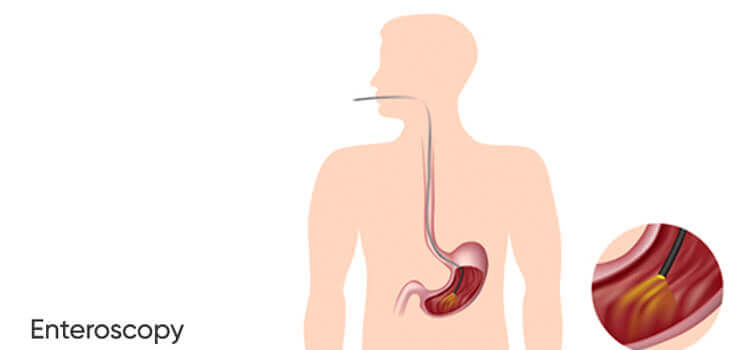
Enteroscopy
Enteroscopy is a procedure used to visualize and evaluate the small intestine, specifically the parts that are not easily accessible with traditional endoscopy or colonoscopy. It allows direct visualization of the small bowel and can aid in diagnosing and treating various gastrointestinal conditions.
Why and when is it done
Enteroscopy may be necessary to examine your small intestine lining if you have
- Abnormal bleeding from your gastrointestinal tract.
- High white blood cell count or other abnormal test results.
- Possible tumor.
- Small bowel obstruction.
- Unexplained malnutrition or poor absorption of nutrients.
- Unexplained severe diarrhea.
- Unexplained severe diarrhea.
- Remove a polyp, mass or foreign object.
- Seal (cauterize) a bleeding lesion on your small intestine lining.
- Stretching open an abnormally tight space in your bowel.
Types of Enteroscopy
There are several types of enteroscopies, difference is the way the tool advances through your small intestine:
- Double balloon: With a double balloon enteroscopy, the endoscope is equipped with two tiny balloons. The balloons inflate and deflate alternately to advance the tool. It’s also called a push-and-pull enteroscopy.
- Single balloon: This technique uses a small balloon at the end of the endoscope to push the tool along. It’s also called a push enteroscopy.
- Spiral overtube: This technique uses a spiral contraption that rotates at the end of the endoscope to move the tool along.
Risks associated with Enteroscopy
Enteroscopy procedures are generally safe, but there's a small risk of:
- Complications from anesthesia.
- Paralytic ileus.
- Internal bleeding.
- Pancreatitis.
- Perforations or tears in the tissue where the tool passed through.
How is the procedure performed
Enteroscopy is performed using specialized instruments called enteroscopes, which are long, flexible tubes with a camera and light source attached to them.
a.Push Enteroscopy:
i. Before the procedure, you may be instructed to fast for a certain period to ensure that your small intestine is empty. The enteroscope is inserted through the mouth or anus and advanced through the upper gastrointestinal tract or colon until it reaches the small intestine. In some cases, a small incision may be made in the small intestine to facilitate insertion. As the enteroscope is advanced, the camera at its tip provides real-time images of the small bowel on a monitor, allowing to visualize the intestinal lining and detect any abnormalities. If any abnormalities are identified during the examination, various interventions can be performed.
b.Balloon Enteroscopy:
i. Similar to push enteroscopy, you may need to fast and receive sedation or anesthesia before the procedure. The enteroscope with an inflatable balloon at its tip is inserted through the mouth or anus. The balloon is deflated during insertion and then inflated once the small intestine is reached to anchor the small bowel and facilitate further advancement. If necessary, various interventions can be performed using the enteroscope, such as biopsy, polyp removal, stricture dilation, or other therapeutic procedures.
